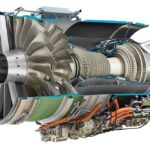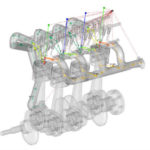A project carried out at the National University of Ireland Galway and Eindhoven University of Technology (TU/e) and KU Leuven has been exploring the role of aerodynamic science in Paralympic cycling. “This work also opens the door for world-class Paralympic athletes to have the same expertise and equipment available to them as other professional athletes. At the world championships and Paralympics where tenths of seconds can decide medals this work can unlock that vital time!”
Innovative Use of HPC in the Cloud for AI, CFD, & LifeScience
Ebru Taylak from the UberCloud gave this talk at the Stanford HPC Conference. “A scalable platform such as the cloud, provides more accurate results, while reducing solution times. In this presentation, we will demonstrate recent examples of innovative use cases of HPC in the Cloud, such as, “Personalized Non-invasive Clinical Treatment of Schizophrenia and Parkinson’s” and “Deep Learning for Steady State Fluid Flow Prediction”. We will explore the challenges for the specific problems, demonstrate how HPC in the Cloud helped overcome these challenges, look at the benefits, and share the learnings.”
Supercomputing Cleaner Power Plants
Researchers are looking to HPC to help engineer cost-effective carbon capture and storage technologies for tomorrow’s power plants. “By combining new algorithmic approaches and a new software infrastructure, MFiX-Exa will leverage future exascale machines to optimize CLRs. Exascale will provide 50 times more computational science and data analytic application power than is possible with DOE high-performance computing systems such as Titan at the Oak Ridge Leadership Computing Facility (OLCF) and Sequoia at Lawrence Livermore National Laboratory.”
Video: The Incredible New Supersonic Affinity Jet Engine from GE
In this video, GE showcases its initial design of the first-ever supersonic engine purpose-built for business jets. The “Affinity” engine is optimized with proven GE technology for supersonic flight and timed to meet the Aerion AS2 launch. “GE Aviation has more than 60 years of experience in designing and building engines adapted for supersonic aircraft. Its first engine to push us into the supersonic era was the J79, which was introduced with Lockheed on their F-104 Starfighter in the mid-1950s.”
Video: Powered by GPUs, Altair and Oracle Accelerate CFD in the Cloud
Today Altair and Oracle announced a joint HPC Cloud solution that leverages GPU technology for exceptional CFD simulation performance. Now part of the Oracle Cloud Infrastructure, the technology effectively accelerates external aerodynamics and other complex flow simulations at scale and at reasonable cost. “The integration with Oracle’s cloud platform addresses this challenge, and provides customers the ability to use GPU-based solvers in the cloud for accelerated performance without the need to purchase expensive hardware.”
Data Science meets CFD: FieldView Analytics in Engineering
Steve Legensky from Intelligent Light gave this talk at the HPC User Forum in Detroit. “CFD may be complex, but Intelligent Light’s goal is simple: our customers’ success. Intelligent Light solutions unlock the power and value of a highly productive CFD workflow for engineering and research organizations in variety of industries around the world.”
Supercomputing Cardiac Arrhythmias
A team of researchers led by Mark Potse from Inria Bordeaux Sud-Ouest research centre are using high performance computing to study heart arrhythmias. It is hoped that this research will lead to better treatment and diagnosis of this condition. “HPC offers enormous potential to advance healthcare through the advances in new therapies and treatments. From understanding the nature of diseases to discovering new drugs and even paradigm shifts in the way that healthcare is delivered such as the development of precision medicine.”
Numeca Migrates CFD to the UberCloud with Advania
CFD solution company Numeca International is expanding HPC offerings to run in the cloud and on demand. With help from Advania and the UberCloud, this capability will make it easer for Numeca customers to tackle complex calculations and improve their flexibility to test them on demand, all while providing them with an HPC environment that accelerates their computing capacity. “Until recently it was my firm belief that cloud computing for engineering applications was one of the next big challenges we had to solve,” says Professor Charles Hirsch, President and founder of NUMECA International, and a world-renowned expert on Computational Fluid Dynamics. “But when we came across UberCloud’s new application HPC container technology and containerized all our CFD software packages, we were surprised about the ease of use and access to any computing system on demand. We were also impressed by the flexibility of Advania to be able to respond to our immediate and future needs, by providing an HPC structure fit to our client’s demands.”
GE’s Flow Simulator Software Now Available Exclusively from Altair
Today Altair announced that the company has added GE’s Flow Simulator software to the Altair Partner Alliance (APA) and offer direct licenses to Altair customers. Flow Simulator is an integrated flow, heat transfer, and combustion design software that enables mixed fidelity simulations to optimize machine and systems design. “GE’s Flow Simulator will benefit our customers by providing thermal fluid system mixed fidelity simulation capabilities relevant to multiple industries. It expands our strong multiphysics system modeling portfolio, and we are very positive about working with GE to carry their great development work forward to a broader set of customers and applications,” said Brett Chouinard, Altair’s President and COO.
Maximizing Performance of HiFUN* CFD Solver on Intel® Xeon® Scalable Processor With Intel MPI Library
The HiFUN CFD solver shows that the latest-generation Intel Xeon Scalable processor enhances single-node performance due to the availability of large cache, higher core density per CPU, higher memory speed, and larger memory bandwidth. The higher core density improves intra-node parallel performance that permits users to build more compact clusters for a given number of processor cores. This permits the HiFUN solver to exploit better cache utilization that contributes to super-linear performance gained through the combination of a high-performance interconnect between nodes and the highly-optimized Intel® MPI Library.













